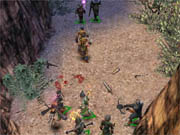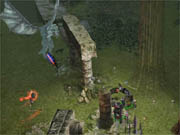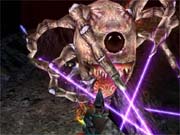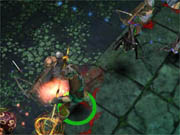When Chris Taylor left Cavedog Entertainment after the release of the acclaimed real-time strategy game Total Annihilation, many gamers were surprised to learn that he would temporarily abandon the strategy genre in order to create a role-playing game. In spite of the shift in genre, the resulting game--Dungeon Siege--has a lot in common with Total Annihilation. Both feature excellent graphics, an accessible interface, capable AI, and varied environments. Dungeon Siege, like Total Annihilation, isn't the most novel game, but it is one of most polished games of its type.

Dungeon Siege is essentially a party-based Diablo that imports some of the interface features of real-time strategy games in order to allow you to easily control multiple characters. It's a hybrid of action and role-playing that consists of an almost constant stream of quickly resolved battles and a flexible but simple skill-based character development system. The setting is a very generic medieval fantasy world, and the game's bland and forgettable story is limited to an almost completely linear trek to dispatch various threats. Chris Taylor and his team of developers have essentially followed the same blueprint they used when creating Total Annihilation, GameSpot's 1997 Game of the Year. They paid only superficial heed to creating an involving plot and instead focused their creative efforts on making an accessible game that is great looking, easy to control, and fast paced. Dungeon Siege has all those attributes, and it's particularly notable for the quality of its graphics.
Dungeon Siege features wonderfully detailed and varied environments. The 3D game engine's most distinctive characteristic is its ability to effectively depict geography of varying heights. While the topography of most gaming worlds is limited to flat terrain occasionally disrupted by slowly rising hills, Dungeon Siege routinely features intimidating cliffs and teetering bridges over seemingly bottomless abysses. The dangers the chaotic landscapes imply are illusory, since your characters are essentially glued to the ground and can never actually fall, and even creatures that appear to be flying essentially just hover slightly above the ground. As in the Myth games, you can take advantage of higher ground to loft arrows and ranged spells at hapless foes perched beneath your party, and there are even explosive weapons and spells with effects that greatly resemble the Molotov cocktails hurled by Myth's dwarven bombardiers. Dungeon Siege's physics system may be less robust than that of the Myth games, but its inclusion adds some tactical complexity, and it is consistently satisfying to watch your characters rain explosives on foes that are positionally disadvantaged.
In addition to its use of heights to great effect, Dungeon Siege's graphics engine is capable of rendering some amazingly varied environments. During the course of the game, your characters will travel through forests crowded with gently swaying trees, icy caverns, beaches infested with hovering gulls, and arid desert landscapes. As the game's name implies, there are also a number of dungeons and caves to explore, and the engine allows for seamless transitions into subterranean environments. It also never needs to halt the gameplay in order to load new areas. The lighting, shadows, and weapon and spell effects all look great, and there's lots of nice attention to detail, such as the rippling water effects that appear when your characters trudge through pools of water.
The characters and monsters are even more graphically detailed than the environments. Each weapon and armor type is distinctive and visible on your characters when equipped, and many magical items have their own individualized appearance. The 3D characters and monsters are so detailed that it appears as if you're playing with sculpted miniatures. By pausing the game, you can freeze spell effects and missile weapons in midair to get a detailed look at any ongoing action. Dungeon Siege offers as much graphical eye candy as any isometric-perspective game to date. It also sounds excellent, combining an ambient orchestral score by now-famous Total Annihilation composer Jeremy Soule with plenty of appropriate sound effects.
The game is very linear, although there are a few ancillary areas and dungeons to explore. You can backtrack, but there's little incentive to do so, since monsters don't respawn and dialogue with non-player characters doesn't change in response to events. In order to allow you to maintain situational awareness, objects like trees become transparent near your party members, and you can easily alter the isometric perspective by rotating, raising, or lowering your viewpoint. Despite that flexibility, trees and some environmental effects like snow and rain still sometimes make it difficult to see much of the area surrounding your characters. However, in those circumstances, you can rely upon the game's capable automap, which clearly identifies all nearby creatures and items and allows you to zoom in your viewpoint to essentially play the game from a top-down perspective.

The character development system is simple and intuitive and features only four skills and three core attributes. Your characters develop their abilities to use melee or ranged weapons, or to cast combat or nature magic spells, based upon the frequency of use of those skills. For example, a character who starts using a bow will gradually develop proficiency with ranged weapons, while a character who prefers casting fireballs will gradually become adept at using combat magic. A character's core attributes are similarly derived from the use of those basic skills, so archers will gain dexterity, melee fighters will augment their strength, and spellcasters will increase in intelligence. It's a character development system that lacks the depth, and inherent replayability, of more complex skill-tree development systems, like the one used by Diablo II. But the advantage of Dungeon Siege's system is that it allows players to just play the game in the manner of their own choosing and let their characters naturally develop the skills needed to accommodate that playing style.
Since Dungeon Siege is party-based, you'll likely sample characters skilled in each of the abilities during the course of playing the game. Unfortunately, these skills are not well balanced. Nature magic, in particular, is much more difficult to rapidly develop compared with the other three skills, since there's an early shortage of effective spells. Characters specializing in nature spells won't get as many opportunities to meaningfully contribute early on in the game, other than by casting healing spells, which by their nature are only useful some time after combat has commenced. It's accordingly difficult to sufficiently develop a character's nature magic ability to allow that character to cast the more formidable spells that become available at higher skill levels. That's less relevant during the single-player game, since even a nature mage with half the experience of the rest of your characters will usually be adequate to keep the rest of your party healed, but it's frustrating to play as such a weak character in multiplayer games, where you're limited to controlling a single character.
In the single-player game you can control up to eight party members, and while you can elect to directly control all of them, they can contribute effectively with minimal supervision. You can individually set how aggressively each character will pursue foes, how they select targets, and when they will initiate combat. There are various formations you can adopt for your party, although their effect upon gameplay is minimal, since your characters can't be hurt by friendly fire. The interface allows you to easily and intuitively adjust the camera angle, pick up treasure, switch weapons, access inventory screens for any or all party members, or essentially accomplish any objective with a couple of mouse clicks. Vulnerable party members, such as the pack mules you can purchase to lug hoards of loot, will retreat from danger, and spellcasters with healing spells equipped will automatically aid their wounded peers. You can pause the game at any time in order to take greater control over the actions of your characters, but well equipped parties are capable of overcoming most foes relatively independently. It's an elegant and always manageable interface that allows players to assume as much control over their party members as they desire.

There are only a couple of minor problems that mar the otherwise flawless interface. There's no way to just keep your party moving in your chosen direction, so you have to keep clicking on your next destination. That simple omission makes moving around less convenient than it could be in the single-player game and cumbersome when playing an online multiplayer game in which lag can prevent the game from immediately recognizing your commands. A second problem with the interface is that there are only four active slots for weapons or spells for each character, and they are reserved for one melee weapon, one ranged weapon, and two spells. Once you specialize a character in a particular ability, you're unlikely to want to frequently access items relating to the other abilities, so the active slots unrelated to your primary ability are effectively wasted. You can pause the game at any time to access other items (or issue commands), but combat is so frequent that you're unlikely to want to regularly fiddle with your preset spells or items. Only having convenient access to a pair of spells results, in practice, in your spellcasters only ever using two spells from the dozens eventually available. Still, the interface is generally excellent.
In addition to the single-player campaign, which can be played in cooperative multiplayer mode, there's also a separate gaming world designed primarily for multiplayer sessions. You can play that setting solo by just starting a multiplayer game alone, but you're only able to play one character in multiplayer games. As a result of that restriction, the game plays quite differently, since you don't have access to a pack mule and are likely to be less tolerant of the disparity in the relative utility of the different class abilities. Since you can't "autoshare" loot and experience points, it's frustrating to be burdened with a character that's incapable of getting a fair share of the conquests. Exacerbating those problems, multiplayer games can quickly devolve into frenzied sessions where everyone is trying to kill as many monsters as possible without working together in any meaningful way.
Furthermore, there are a great number of spells designed to strengthen your characters, weaken opponents, or summon creatures in the single-player game that become far less useful when you are required to focus your attention on a single character in the multiplayer game. The game's controls seem very susceptible to online lag, and the resulting delays in recognizing commands can make the game exasperating. Since you use a single click to both move and attack enemies, delays in recognizing commands can cause your character to move instead of attacking as intended or vice versa. Ultimately, because the game had to be designed to be playable when you are controlling a party of characters, the simple and streamlined controls mean that the game is at its least interesting when you're controlling only one character. Still, the multiplayer version of the game has potential, since you can set up team-based battles and the developers intend to facilitate the creation of additional player-created modifications and content.

There's a huge variety of monster types in the game, most of which have their own unique character models. Since the gameplay primarily revolves around dispatching hordes of enemies, enemy behavior is relatively simplistic. Most monsters will simply charge your party when approached, stopping to attack as soon as they are in range, although some enemies will also retreat when threatened. There are a few science-fiction elements scattered throughout the game that are incongruent with the medieval fantasy setting, but since the game doesn't have an involving story or setting to begin with, few gamers are likely to be upset with such heterogeneity. Even though there is such a wide mix of monsters, the constant battles still get repetitive, and advancing through some of the game's dungeon crawls can become tedious. Nevertheless, all the various environments you'll traverse and enemies you'll face will keep you interested. One distinguishing feature of the battles is their scale, since near the end of the game you'll frequently be forced to overcome virtual armies of enemies.
While its party-based gameplay is a little more tactical and less frantic than that of other action RPG titles like Nox and the Diablo games, Dungeon Siege still plays very similarly to those games. It's a fast-paced hack-and-slash game, so if you're looking for a deeper role-playing game or one in which the primary goal isn't to liberate excessive quantities of loot from its owners, then Dungeon Siege isn't really for you. But its polished interface, accessible gameplay, and exceptional graphics make Dungeon Siege a first-rate action RPG.



